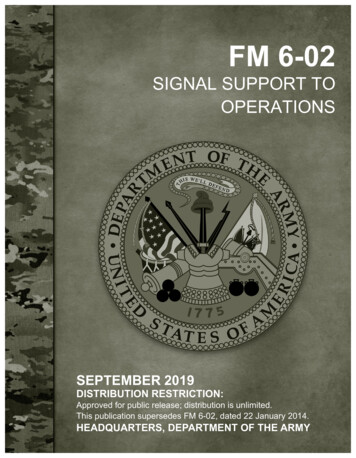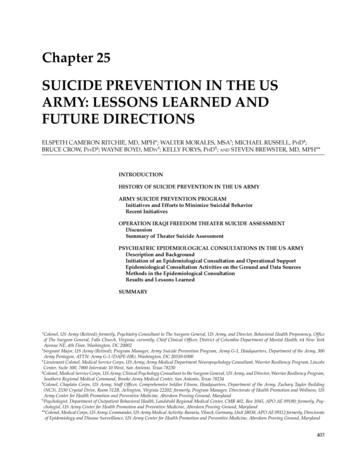
Transcription
CASE STUDYArmy Cyber SchoolLeverages FD.io to AchieveSuperior NetworkPerformance and ScaleUse case enables training programs and cloudinfrastructure to support a growing user base
BusinessThe US Army Cyber Center of Excellence was started in October, 2015. Ascyberspace is now one of the key defense domains along with land, sea and air,the center has the important task of training army soldiers in cyber technologies.The school takes the standards provided by the U.S. Cyber Command and theU.S. Army as key inputs for formulating learning outcomes. The objectives areto equip the students with sufficient hands-on cybersecurity knowledge sothey become adept in cyber warfare, both in cyber defense as well as offensivecampaigns. While the standards dictate the learning objectives, the school createsthe content and delivery mechanisms that are timely and relevant in the context ofa rapidly evolving cyber domain. The school follows an agile process for creating,updating and delivering training content spanning documents, scripts, systemresources provisioning (target systems, attacker nodes and defending nodes [VMs/containers]), using an automated revision control approach or “training-as-code”.The formal name for the solution is “Broadband Handrail” to denote the ongoingsupport to students and alumni get through their cybersecurity learning.The school trains more than 500 students annually. The students come from arange of educational levels, from high school graduates to college graduates withdifferent majors. The school also provides the alumni access to the school trainingsystems and resources as long as they are in the service--allowing them to refreshtheir knowledge and continue contributing to the knowledge base. Currently, thenumber of total active users is more than 8,000 and growing.ChallengesWith the ongoing proliferation of always-on cloud-connected communicationdevices, computing equipment and the Internet of Things (IOT), cyber attack vectorsand trends are evolving at a rapid pace. The school recognizes the need for highperformance, low-cost, open standards-based agile cloud-based environmentto develop, deliver and update relevant training courses. Despite being a part ofa highly structured operating environment, the school has been able to deliveran innovative and agile model for the cloud using already available hardwareinfrastructure, e.g. servers; internet connectivity, e.g. LTE; and facilities. The privatecloud is used for both hosting hands-on lab exercises and ad-hoc experiments.The school prefers open source solutions for transparency, community-driveninnovation, increased agility, and the ability to run on high volume, commodityCASE STUDY: Army Cyber School Leverages FD.io to Achieve Superior Network Performance and Scale2
hardware. It selected solutions such as Linux and OpenStack for compute andstorage software needs. Until recently, the school had been using pfSense opensource network connectivity and security solution for its cloud networking andsecurity software needs. pfSense is a widely used open-source secure routing andfirewall solution.Some of the upcoming performance and scale needs of the private cloud are tosupport: 8,000 and growing user user base using thousands of tenant networks 100 Gbps line rate east-west traffic with routing, network address translation(NAT), port forwarding, and firewall with policy enforcement Several thousand route configurations in the network security solution IPSec and Layer 7 security functions such as threat detection/protection,Anti-X1 without materially degrading performance API based dynamic configuration and control Various CPU architectures such as Intel, arm, MIPS, and Power2As the school’s east-west network traffic needs have been growing progressively,the pfSense-based solution had become a bottleneck in terms of performance,scale and agility needs. The school wanted not only to overcome the bottlenecks interms of current needs, but also to “future provision” the capacity for next few yearsto streamline the infrastructure procurement approval process. For example, thenetwork may need to support experiments such as spinning up 10,000 containersacting as BGP routers. The entire learning environment needs to be enabled via selfservice automated user portal.In summary the school needs a high performance, scalable, robust, low cost open,programmable, source network forwarding and security solution that can efficientlyrun on commodity hardware already available.1. A combination of anti-virus, anti-spam, anti-spyware, anti-theft etc.2. The various trademarks belong to the rightful owners.CASE STUDY: Army Cyber School Leverages FD.io to Achieve Superior Network Performance and Scale3
SolutionTo solve the east-west network performance and scale problem, the school consideredseveral alternatives to pfSense, including commercial software, proprietary integratedhardware and software, and TNSR from Netgate. TNSR is an open source advanced router,firewall and VPN networking solution with enterprise grade quality, high-performance andprogrammable management capabilities. At the core of the TNSR solution are two highlyefficient open source packet processing functions, FD.io project and DPDK. Thesepacket processing projects are both part of the Linux Foundation, as is the Free RangeRouting (FRR) project with the product’s control plane. The school ultimately choseTNSR based on FD.io and DPDK. The TNSR block diagram is illustrated in Figure 1.Figure 1 TNSR Block DiagramFD.io (Fast data – Input/Output) is a set of Linux Foundation projects and librariesthat support robust, flexible, programmable and composable services on commodityhardware platforms. FD.io offers software-based high-performance, low-latency andresource-efficient networking packet processing solutions for bare metal, VM andCloud Native(container) in a combination of deployment environments.CASE STUDY: Army Cyber School Leverages FD.io to Achieve Superior Network Performance and Scale4
A key component of FD.io is the Vector Packet Processing (VPP) library. VPP is a highlymodular, flexible software packet processing block allowing for new packet processingfunctions to be easily “plugged in” without changes to the underlying code base. Themain innovation in VPP is that it processes a number of packets in parallel insteadof one at a time. This spreads the overhead of lookups and instruction cache codefetches across an entire set of packets - contributing to a dramatic improvementin efficiency. Hence, the performance scales linearly in proportion with deployedCPU/thread count in a deterministic manner, and with low latency. FD.io supportsdeveloper friendly features such as runtime counters (for throughput, IPC, errors,etc.), pipeline tracing facilities, multi-language API bindings and VPP commandline introspection. This efficiency and flexibility gives developers and integratorsthe potential to easily build a variety of packet processing solutions ranging fromlayer 2 all the way up to layer 7 applications. Fd.io VPP readily supports widely usednetwork functions such as layer 2 - layer 4 stack, IPSec and more. When combinedwith DPDK, VPP processing can occur in user mode using a polling driver instead ofbeing interrupt driven. This further contributes to its performance and scale benefits.Figure 2 below describes how FD.io fits in the broader ecosystem of open sourcenetworking and computing initiatives.Application LayerOrchestratione.g. Routing, Port Forwarding, Firewall, IPSec, etc. in this use caseeg.Network Controllereg.Data Plane ServicesDataplaneManagement AgentOperation gure 2 FD.io in the overall cloud stackCASE STUDY: Army Cyber School Leverages FD.io to Achieve Superior Network Performance and Scale5
The school chose the FD.io-based TNSR solution since it fit the school’s abovelisted networking needs in terms of being open-source, high performance, scalable,capable of running on commodity hardware, programmable and cost efficient. Theperformance and scale were achieved on existing hardware without any additionalcapital expenditures. The programmable management capability aligned with theschool’s agile continuous integration (CI), and continuous delivery (CD) methodologyof rolling out the Broadband Handrail program.ResultsTNSR, with FD.io VPP and DPDK at its core, delivers high-performance packetprocessing with low latency for routing, NAT, port forwarding, firewall functionality—all running on commodity hardware. The FD.io engine also provides greaterscalability across a number of metrics.The following table summarizes the school’s experience with a pfSense solutionversus the TNSR solution.AspectSolutionProblemUser experienceBefore FD.iopfSense (hybrid — Kernel& Userspace) packetprocessingInefficient use of hardware,low performance, manualconfigurationSlow and manualAfter FD.ioFd.io (userspace VPP &DPDK) packet processingEfficient utilization of hardware, Line-rate 100 Gbpsperformance, automationFast and automatedTable 1: Before and After Migration to Fd.io based solutionCASE STUDY: Army Cyber School Leverages FD.io to Achieve Superior Network Performance and Scale6
Next Steps and ConclusionThe school plans to exercise the IPSec functionality of the solution in the near futureto secure the traffic between its training network and its Microsoft Azure basedvirtual private cloud network. Once encryption enters the picture, TNSR is expectedto far outperform pfSense performance, making the upgrade even more valuable.The school also plans to open source the cybersecurity tools and templates to makethem accessible to a wider community at no cost.With a FD.io-based TNSR solution, The US Army Cyber School is successfullyaddressing the evolving networking and security needs of their training cloudinfrastructure for openness, high performance, scale, programmability and cost.3Referenceshttps://www.youtube.com/watch?v fRRiQVxbQ1ghttps://www.youtube.com/watch?v UQ0gcqKEAGshttps://www.youtube.com/watch?v f5MRdaM-E0g&t incyber-soldiers.html3. Participation in this case study is in no way to be considered an endorsement of a product bythe Department of Defense, nor can it be indicated in any product advertisement that such anendorsement exists.CASE STUDY: Army Cyber School Leverages FD.io to Achieve Superior Network Performance and Scale7
storage software needs. Until recently, the school had been using pfSense open-source network connectivity and security solution for its cloud networking and security software needs. pfSense is a widely used open-source secure routing and firewall solution. Some of the upcoming performance and scale needs of the private cloud are to support:











